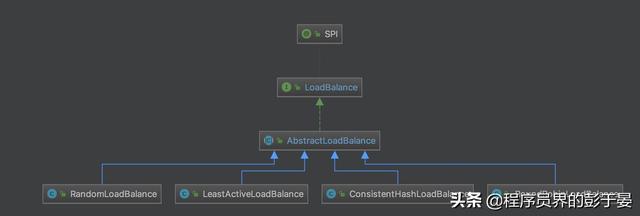谈谈Dubbo负载均衡是如何实现的?


dubbo的负载均衡全部由AbstractLoadBalance的子类来实现
RandomLoadBalance 随机
在一个截面上碰撞的概率高,但调用量越大分布越均匀,而且按概率使用权重后也比较均匀,有利于动态调整提供者权重。
- 获取invoker的数量
- 获取第一个invoker的权重,并复制给firstWeight
- 循环invoker集合,把它们的权重全部相加,并复制给totalWeight,如果权重不相等,那么sameWeight为false
- 如果invoker集合的权重并不是全部相等的,那么获取一个随机数在1到totalWeight之间,赋值给offset属性
- 循环遍历invoker集合,获取权重并与offset相减,当offset减到小于零,那么就返回这个inovker
- 如果权重相等,那么直接在invoker集合里面取一个随机数返回
@Override
protected <T> Invoker<T> doSelect(List<Invoker<T>> invokers, URL url, Invocation invocation) {
int length = invokers.size(); // Number of invokers
boolean sameWeight = true; // Every invoker has the same weight?
int firstWeight = getWeight(invokers.get(0), invocation);
int totalWeight = firstWeight; // The sum of weights
for (int i = 1; i < length; i++) {
int weight = getWeight(invokers.get(i), invocation);
totalWeight += weight; // Sum
if (sameWeight && weight != firstWeight) {
sameWeight = false;
}
}
if (totalWeight > 0 && !sameWeight) {
// If (not every invoker has the same weight & at least one invoker's weight>0), select randomly based on totalWeight.
int offset = ThreadLocalRandom.current().nextInt(totalWeight);
// Return a invoker based on the random value.
for (int i = 0; i < length; i++) {
offset -= getWeight(invokers.get(i), invocation);
if (offset < 0) {
return invokers.get(i);
}
}
}
// If all invokers have the same weight value or totalWeight=0, return evenly.
return invokers.get(ThreadLocalRandom.current().nextInt(length));
}
RoundRobinLoadBalance 轮询
存在慢的提供者累积请求的问题,比如:第二台机器很慢,但没挂,当请求调到第二台时就卡在那,久而久之,所有请求都卡在调到第二台上。
在老的版本上,dubbo会求出最大权重和最小权重,如果权重相等,那么就直接按取模的方式,每次取完后值加一;如果权重不相等,顺序根据权重分配。
在新的版本上,对这个类进行了重构。
- 从methodWeightMap这个实例中根据ServiceKey+MethodName的方式获取里面的一个map实例,如果没有则说明第一次进到该方法,则实例化一个放入到methodWeightMap中,并把获取到的实例命名为map
- 遍历所有的invokers
- 拿到当前的invoker的identifyString作为key,去map里获取weightedRoundRobin实例,如果map里没有则添加一个
- 如果weightedRoundRobin的权重和当前invoker的权重不同,说明权重变了,需要重新设置
- 获取当前invoker所对应的weightedRoundRobin实例中的current,并加上当前invoker的权重
- 设置weightedRoundRobin最后的更新时间
- maxCurrent一开始是设置的0,如果当前的weightedRoundRobin的current值大于maxCurrent则进行赋值
- 遍历完后会得到最大的权重的invoker的selectedInvoker和这个invoker所对应的weightedRoundRobin赋值给了selectedWRR,还有权重之和totalWeight
- 然后把selectedWRR里的current属性减去totalWeight,并返回selectedInvoker
这样看显然是不够清晰的,我们来举个例子:
假定有3台dubbo provider:
10.0.0.1:20884, weight=2
10.0.0.1:20886, weight=3
10.0.0.1:20888, weight=4
totalWeight=9;
那么第一次调用的时候:
10.0.0.1:20884, weight=2 selectedWRR -> current = 2
10.0.0.1:20886, weight=3 selectedWRR -> current = 3
10.0.0.1:20888, weight=4 selectedWRR -> current = 4
selectedInvoker-> 10.0.0.1:20888
调用 selectedWRR.sel(totalWeight);
10.0.0.1:20888, weight=4 selectedWRR -> current = -5
返回10.0.0.1:20888这个实例
那么第二次调用的时候:
10.0.0.1:20884, weight=2 selectedWRR -> current = 4
10.0.0.1:20886, weight=3 selectedWRR -> current = 6
10.0.0.1:20888, weight=4 selectedWRR -> current = -1
selectedInvoker-> 10.0.0.1:20886
调用 selectedWRR.sel(totalWeight);
10.0.0.1:20886 , weight=4 selectedWRR -> current = -3
返回10.0.0.1:20886这个实例
那么第三次调用的时候:
10.0.0.1:20884, weight=2 selectedWRR -> current = 6
10.0.0.1:20886, weight=3 selectedWRR -> current = 0
10.0.0.1:20888, weight=4 selectedWRR -> current = 3
selectedInvoker-> 10.0.0.1:20884
调用 selectedWRR.sel(totalWeight);
10.0.0.1:20884, weight=2 selectedWRR -> current = -3
返回10.0.0.1:20884这个实例
protected <T> Invoker<T> doSelect(List<Invoker<T>> invokers, URL url, Invocation invocation) {
String key = invokers.get(0).getUrl().getServiceKey() + "." + invocation.getMethodName();
ConcurrentMap<String, WeightedRoundRobin> map = methodWeightMap.get(key);
if (map == null) {
methodWeightMap.putIfAbsent(key, new ConcurrentHashMap<String, WeightedRoundRobin>());
map = methodWeightMap.get(key);
}
int totalWeight = 0;
long maxCurrent = Long.MIN_VALUE;
long now = System.currentTimeMillis();
Invoker<T> selectedInvoker = null;
WeightedRoundRobin selectedWRR = null;
for (Invoker<T> invoker : invokers) {
String identifyString = invoker.getUrl().toIdentityString();
WeightedRoundRobin weightedRoundRobin = map.get(identifyString);
int weight = getWeight(invoker, invocation);
if (weight < 0) {
weight = 0;
}
if (weightedRoundRobin == null) {
weightedRoundRobin = new WeightedRoundRobin();
weightedRoundRobin.setWeight(weight);
map.putIfAbsent(identifyString, weightedRoundRobin);
weightedRoundRobin = map.get(identifyString);
}
if (weight != weightedRoundRobin.getWeight()) {
//weight changed
weightedRoundRobin.setWeight(weight);
}
long cur = weightedRoundRobin.increaseCurrent();
weightedRoundRobin.setLastUpdate(now);
if (cur > maxCurrent) {
maxCurrent = cur;
selectedInvoker = invoker;
selectedWRR = weightedRoundRobin;
}
totalWeight += weight;
}
if (!updateLock.get() && invokers.size() != map.size()) {
if (updateLock.compareAndSet(false, true)) {
try {
// copy -> modify -> update reference
ConcurrentMap<String, WeightedRoundRobin> newMap = new ConcurrentHashMap<String, WeightedRoundRobin>();
newMap.putAll(map);
Iterator<Entry<String, WeightedRoundRobin>> it = newMap.entrySet().iterator();
while (it.hasNext()) {
Entry<String, WeightedRoundRobin> item = it.next();
if (now - item.getValue().getLastUpdate() > RECYCLE_PERIOD) {
it.remove();
}
}
methodWeightMap.put(key, newMap);
} finally {
updateLock.set(false);
}
}
}
if (selectedInvoker != null) {
selectedWRR.sel(totalWeight);
return selectedInvoker;
}
// should not happen here
return invokers.get(0);
}
LeastActiveLoadBalance 最少活跃调用数
使慢的提供者收到更少请求,因为越慢的提供者的调用前后计数差会越大。
- 遍历所有的invoker
- 获取当前invoker的活跃数,调用的是RpcStatus的getStatus方法,过滤器里面会记录每个方法的活跃数
- 获取当前invoker的权重
- 如果是第一次进来或者是当前invoker的活跃数比最小的活跃数还小
- 那么把leastActive设置为当前invoker的活跃数,设置leastCount为1,leastIndexes数组的第一个位置设置为1,记录一下totalWeight和firstWeight
- 如果不满足第4点的条件,那么判断当前invoker的活跃数和最小的活跃数是否相等
- 如果满足第6点,那么把当前的权重加入到totalWeight中,并把leastIndexes数组中记录一下最小活跃数相同的下标;再看一下是否所有的权重相同
- 如果invoker集合中只有一个invoker活跃数是最小的,那么直接返回
- 如果权重不相等,随机权重后,判断在哪个 Invoker 的权重区间中
- 权重相等,直接随机选择 Invoker 即可
最小活跃数算法实现:
假定有3台dubbo provider:
10.0.0.1:20884, weight=2,active=2
10.0.0.1:20886, weight=3,active=4
10.0.0.1:20888, weight=4,active=3
active=2最小,且只有一个2,所以选择10.0.0.1:20884
假定有3台dubbo provider:
10.0.0.1:20884, weight=2,active=2
10.0.0.1:20886, weight=3,active=2
10.0.0.1:20888, weight=4,active=3
active=2最小,且有2个,所以从[10.0.0.1:20884,10.0.0.1:20886 ]中选择;
接下来的算法与随机算法类似:
假设offset=1(即random.nextInt(5)=1)
1-2=-1<0?是,所以选中 10.0.0.1:20884, weight=2
假设offset=4(即random.nextInt(5)=4)
4-2=2<0?否,这时候offset=2, 2-3<0?是,所以选中 10.0.0.1:20886, weight=3
1: public class LeastActiveLoadBalance extends AbstractLoadBalance {
2:
3: public static final String NAME = "leastactive";
4:
5: private final Random random = new Random();
6:
7: @Override
8: protected <T> Invoker<T> doSelect(List<Invoker<T>> invokers, URL url, Invocation invocation) {
9: int length = invokers.size(); // 总个数
10: int leastActive = -1; // 最小的活跃数
11: int leastCount = 0; // 相同最小活跃数的个数
12: int[] leastIndexes = new int[length]; // 相同最小活跃数的下标
13: int totalWeight = 0; // 总权重
14: int firstWeight = 0; // 第一个权重,用于于计算是否相同
15: boolean sameWeight = true; // 是否所有权重相同
16: // 计算获得相同最小活跃数的数组和个数
17: for (int i = 0; i < length; i++) {
18: Invoker<T> invoker = invokers.get(i);
19: int active = RpcStatus.getStatus(invoker.getUrl(), invocation.getMethodName()).getActive(); // 活跃数
20: int weight = invoker.getUrl().getMethodParameter(invocation.getMethodName(), Constants.WEIGHT_KEY, Constants.DEFAULT_WEIGHT); // 权重
21: if (leastActive == -1 || active < leastActive) { // 发现更小的活跃数,重新开始
22: leastActive = active; // 记录最小活跃数
23: leastCount = 1; // 重新统计相同最小活跃数的个数
24: leastIndexes[0] = i; // 重新记录最小活跃数下标
25: totalWeight = weight; // 重新累计总权重
26: firstWeight = weight; // 记录第一个权重
27: sameWeight = true; // 还原权重相同标识
28: } else if (active == leastActive) { // 累计相同最小的活跃数
29: leastIndexes[leastCount++] = i; // 累计相同最小活跃数下标
30: totalWeight += weight; // 累计总权重
31: // 判断所有权重是否一样
32: if (sameWeight && weight != firstWeight) {
33: sameWeight = false;
34: }
35: }
36: }
37: // assert(leastCount > 0)
38: if (leastCount == 1) {
39: // 如果只有一个最小则直接返回
40: return invokers.get(leastIndexes[0]);
41: }
42: if (!sameWeight && totalWeight > 0) {
43: // 如果权重不相同且权重大于0则按总权重数随机
44: int offsetWeight = random.nextInt(totalWeight);
45: // 并确定随机值落在哪个片断上
46: for (int i = 0; i < leastCount; i++) {
47: int leastIndex = leastIndexes[i];
48: offsetWeight -= getWeight(invokers.get(leastIndex), invocation);
49: if (offsetWeight <= 0) {
50: return invokers.get(leastIndex);
51: }
52: }
53: }
54: // 如果权重相同或权重为0则均等随机
55: return invokers.get(leastIndexes[random.nextInt(leastCount)]);
56: }
57:
58: }
ConsistentHashLoadBalance 一致性 Hash
相同参数的请求总是发到同一提供者。当某一台提供者挂时,原本发往该提供者的请求,基于虚拟节点,平摊到其它提供者,不会引起剧烈变动。
- 基于 invokers 集合,根据对象内存地址来计算定义哈希值
- 获得 ConsistentHashSelector 对象。若为空,或者定义哈希值变更(说明 invokers 集合发生变化),进行创建新的 ConsistentHashSelector 对象
- 调用ConsistentHashSelector对象的select方法
1: public class ConsistentHashLoadBalance extends AbstractLoadBalance {
2:
3: /**
4: * 服务方法与一致性哈希选择器的映射
5: *
6: * KEY:serviceKey + "." + methodName
7: */
8: private final ConcurrentMap<String, ConsistentHashSelector<?>> selectors = new ConcurrentHashMap<String, ConsistentHashSelector<?>>();
9:
10: @SuppressWarnings("unchecked")
11: @Override
12: protected <T> Invoker<T> doSelect(List<Invoker<T>> invokers, URL url, Invocation invocation) {
13: String key = invokers.get(0).getUrl().getServiceKey() + "." + invocation.getMethodName();
14: // 基于 invokers 集合,根据对象内存地址来计算定义哈希值
15: int identityHashCode = System.identityHashCode(invokers);
16: // 获得 ConsistentHashSelector 对象。若为空,或者定义哈希值变更(说明 invokers 集合发生变化),进行创建新的 ConsistentHashSelector 对象
17: ConsistentHashSelector<T> selector = (ConsistentHashSelector<T>) selectors.get(key);
18: if (selector == null || selector.identityHashCode != identityHashCode) {
19: selectors.put(key, new ConsistentHashSelector<T>(invokers, invocation.getMethodName(), identityHashCode));
20: selector = (ConsistentHashSelector<T>) selectors.get(key);
21: }
22: return selector.select(invocation);
23: }
24: }
ConsistentHashSelector 一致性哈希选择器
ConsistentHashSelector ,是 ConsistentHashLoadBalance 的内部类,一致性哈希选择器,基于 Ketama 算法。
/**
* 虚拟节点与 Invoker 的映射关系
*/
private final TreeMap<Long, Invoker<T>> virtualInvokers;
/**
* 每个Invoker 对应的虚拟节点数
*/
private final int replicaNumber;
/**
* 定义哈希值
*/
private final int identityHashCode;
/**
* 取值参数位置数组
*/
private final int[] argumentIndex;
1: ConsistentHashSelector(List<Invoker<T>> invokers, String methodName, int identityHashCode) {
2: this.virtualInvokers = new TreeMap<Long, Invoker<T>>();
3: // 设置 identityHashCode
4: this.identityHashCode = identityHashCode;
5: URL url = invokers.get(0).getUrl();
6: // 初始化 replicaNumber
7: this.replicaNumber = url.getMethodParameter(methodName, "hash.nodes", 160);
8: // 初始化 argumentIndex
9: String[] index = Constants.COMMA_SPLIT_PATTERN.split(url.getMethodParameter(methodName, "hash.arguments", "0"));
10: argumentIndex = new int[index.length];
11: for (int i = 0; i < index.length; i++) {
12: argumentIndex[i] = Integer.parseInt(index[i]);
13: }
14: // 初始化 virtualInvokers
15: for (Invoker<T> invoker : invokers) {
16: String address = invoker.getUrl().getAddress();
17: // 每四个虚拟结点为一组,为什么这样?下面会说到
18: for (int i = 0; i < replicaNumber / 4; i++) {
19: // 这组虚拟结点得到惟一名称
20: byte[] digest = md5(address + i);
21: // Md5是一个16字节长度的数组,将16字节的数组每四个字节一组,分别对应一个虚拟结点,这就是为什么上面把虚拟结点四个划分一组的原因
22: for (int h = 0; h < 4; h++) {
23: // 对于每四个字节,组成一个long值数值,做为这个虚拟节点的在环中的惟一key
24: long m = hash(digest, h);
25: virtualInvokers.put(m, invoker);
26: }
27: }
28: }
29: }
public Invoker<T> select(Invocation invocation) {
// 基于方法参数,获得 KEY
String key = toKey(invocation.getArguments());
// 计算 MD5 值
byte[] digest = md5(key);
// 计算 KEY 值
return selectForKey(hash(digest, 0));
}
private String toKey(Object[] args) {
StringBuilder buf = new StringBuilder();
for (int i : argumentIndex) {
if (i >= 0 && i < args.length) {
buf.append(args[i]);
}
}
return buf.toString();
}
private Invoker<T> selectForKey(long hash) {
// 得到大于当前 key 的那个子 Map ,然后从中取出第一个 key ,就是大于且离它最近的那个 key
Map.Entry<Long, Invoker<T>> entry = virtualInvokers.tailMap(hash, true).firstEntry();
// 不存在,则取 virtualInvokers 第一个
if (entry == null) {
entry = virtualInvokers.firstEntry();
}
// 存在,则返回
return entry.getValue();
}
正文到此结束
热门推荐
相关文章
Loading...











![[HBLOG]公众号](https://www.liuhaihua.cn/img/qrcode_gzh.jpg)

